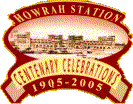|
|
|
||
| In the early part of the 19th. Century, the place where Howrah Station came up, there was an orphanage run by Dominican Sect of a group of Portuguese Missionaries. It was sold to the East Indian Railway, where work soon began for the Howrah Station. | |||
The station consisted of a temporary shed which served as a Platform - " five minutes' walk from the muddy bank of Ganga." There was no landing ghat on the Howrah side, although there was something of a kind on the other bank of the river. The Armenian ghat had a ticket counter from where the train tickets were issued. The ticket included the fare of crossing the river. For passengers from Howrah side, after arrival at the shed, which served as a platform, passengers had to jostle their way through the "exciting" crowd to the " Booking Window " . A single "Booking Window" supplied tickets to all classes of passengers. This was the scenario immediately after inauguration. Currently Howrah station stands where there was an orphanage run by Dominican Sect of Portuguese Missionaries. Next to it was a small church run by the same sect. Unfortunately due to out break of plague the orphanage was shifted to Calcutta. The place was purchased by the East Indian Railway Co. The newly formed Railway Company which had already began its passenger services at Howrah built a few tin sheds here to facilitate maintenance work. and train formation yard before train running. The rest of the empty space on northern side was utilised in storage of materials. Subsequently this became the stores depot of East Indian Railway.(Still exists) |
|||
|
|
|||
|
|
|
||


